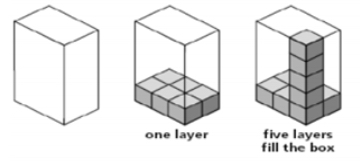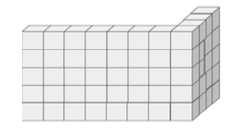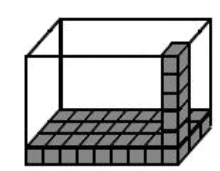General Information
Benchmark Instructional Guide
Connecting Benchmarks/Horizontal Alignment
Terms from the K-12 Glossary
- NA
Vertical Alignment
Previous Benchmarks
Next Benchmarks
Purpose and Instructional Strategies
- This benchmark introduces volume to students. Their prior experiences with volume were restricted to liquid volume (also called capacity). The concept of volume should be extended from the understanding of area starting in Grade 3 (MA.3.GR.2.1), with the idea that a layer (such as the bottom of cube) can be built up by adding more layers of unit cubes. In Grade 6, (MA.6.GR.2.3) students solve volume problems involving rectangular prisms with fraction and decimal side lengths.
- As students develop their understanding of volume, they recognize that a 1-unit by 1-unit by 1-unit cube is the standard unit for measuring volume. This cube has a length of 1 unit, a width of 1 unit and a height of 1 unit and is called a cubic unit. This cubic unit is written with an exponent of 3 (e.g., in3, 33). Students connect this notation to their understanding of powers of 10 in our place value system (MTR.5.1).

Common Misconceptions or Errors
- Students may incorrectly fill figures to find volume with cubes. Students need to ensure there is no empty space included and that unit cubes are equally-sized and packed tightly in without overlaps.
Strategies to Support Tiered Instruction
- Instruction includes providing unit cubes and having students build rectangular prisms with specific dimensions and then calculating the volume.
- For example, the teacher provides students with unit cubes and the following dimensions: length is 8 units, width is 4 units, and height is 5 units. Students stack equally sized unit cubes and ensure that the cubes are packed tightly with no gaps or overlaps to create a solid three-dimensional figure. Students begin building the figure as shown below, continuing to fill it in until complete. Students calculate the volume by multiplying 8 × 4 × 5 and then decompose the figure and count the cubes to determine if their calculation is correct.

- Instruction includes providing rectangular prisms filled with cubes. Some are filled correctly with no gaps or overlaps, and others have the cubes filling the rectangular prism, but with gaps left between them. Students identify which are stacked correctly to find volume and which are not stacked correctly and record the dimensions of the number of cubes for the height, length, and width, counting the total to determine the volume.
Instructional Tasks
Instructional Task 1 (MTR.6.1)
Molly is putting her cube-shaped blocks into their storage container after she finishes playing with her sister. The storage container is shaped like a right rectangular prism and she has a total of 120 blocks. The bottom layer of her storage container holds exactly 6 rows of 4 blocks each with no gaps or overlaps. The storage container holds exactly 6 layers of blocks with no gaps or overlaps.- Part A. Will all of Molly’s blocks fit in the storage container? Explain how you know using drawings and equations.
- Part B. If there is enough room, determine how many more blocks Molly could fit in the storage container. If there is not enough room, determine how many blocks will not fit be able to fit in the storage container.
Instructional Items
Instructional Item 1
What is the volume of the right rectangular prism?
*The strategies, tasks and items included in the B1G-M are examples and should not be considered comprehensive.
